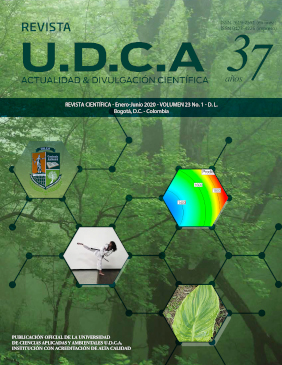Estrategias de manejo de Senecio vulgaris L. asociado al cultivo de Daucus carota L. a partir de los principios de la modelación biológica
Management strategies of Senecio vulgaris L. associated to Daucus carota L. from the principles of biological modeling
Contenido principal del artículo
Resumen
Senecio vulgaris L. es una maleza, considerada de difícil control cuando se asocia a la zanahoria, debido a que compite por recursos con el cultivo, siendo importante su control, ya que tiene un impacto negativo en la productividad. La modelación biológica es una herramienta que permite prever los posibles efectos del control de la especie, ya que identifica las diferentes variables de un sistema y los factores que las afecta, para de este modo, predecir los resultados en diversos ambientes. Con base en la dinámica de sistemas y los aspectos morfo-fisiológicos de la especie, se planteó la modelación del banco de semillas de S. vulgaris, basado en las ecuaciones planteadas por Fernández-Quintanilla, donde se construyó el diagrama Forrester, al que se le incorporaron las diferentes ecuaciones y valores del modelo, para proyectar la dinámica de la especie en el banco de semillas, dependiendo del manejo. Se propusieron tres escenarios: (1) control con herbicidas en post-emergencia, (2) rotación de cultivos y (3) incorporar los métodos culturales de control, con un testigo en pre siembra y rotación de cultivos. Los resultados del modelo muestran que cuando se realiza rotación de cultivos y se incorporan manejos en pre-siembra al proceso convencional de la especie, se presenta una menor cantidad de semillas en el banco.
Palabras clave:
Descargas
Datos de publicación
Perfil evaluadores/as N/D
Declaraciones de autoría
- Sociedad académica
- Universidad de Ciencias Aplicadas UDCA
- Editorial
- Universidad de Ciencias Aplicadas y Ambientales U.D.C.A
Detalles del artículo
Referencias (VER)
AGRONET. 2019. Red de información y comunicación del sector agropecuario. Colombia. Cifras agropecuarias Disponible desde Internet en: www.agronet.gov.co (con acceso 11/10/2020).
ALONSO-AYUSO, M.; GABRIEL, J.; GONZÁLEZ, I.; DEL MONTE, J.; QUEMADA, M. 2018. Weed density and diversity in a long-term cover crop experiment background. Crop Protection. 112(1):103-111. https://doi.org/10.1016/j.cropro.2018.04.012
ANISIU, M.C. 2014. Lotka, Volterra and their model. Didáctica mathematica. 32(1):9-17.
AUTRAN, V.; PURICELLI, E.; FACCINI, D.; PALAZZESI, G.; BENITEZ, C. 2013. Competencia entre Adesmia bicolor y distintas especies de malezas. Ciencias Agronómicas. 21:7-11.
BECKIE, H.; TARDIF, F. 2011. Herbicide cross resistance in weeds. Crop Protection. 35:15-28. https://doi.org/10.1016/j.cropro.2011.12.018
BOER, T.; SMITH, P.; CHANDLER, K.; NURSE, R.; OBEID, K.; SWANTON, C. 2019. A linuron-free sede management strategy for carrots. Weed Technology, 33(3):464-474. https://doi.org/10.1017/wet.2018.112
CARDENAL, Z.; TORRES, D.; DOTOR, M.; MORILLO, A. 2016. Caracterización del banco activo de semillas en cultivos de zanahoria del municipio de Villa Pinzón (Cundinamarca). Rev. U.D.C.A Act. & Div. Cient. 19(2):297-306. https://doi.org/10.31910/rudca.v19.n2.2016.83
CHAY, D.; DELFÍN, H.; MELÉNDEZ, V.; GONZÁLEZ, A. 2012. Revisión de modelos predictivos de especies de control biológico. Tropical and Subtropical Agroecosystems. 15(1):337-356.
CHENG, D.; TIAN, Z.; FENG, L.; XU, L.; WANG, H. 2019. Diversity analysis of the rhizospheric and endophytic bacterial communities of Senecio vulgaris L. (Asteraceae) in an invasive range. Peer J Life & Environment. 6(1):1-24. https://doi.org/10.7717/peerj.6162
DÉLYE, C.; CAUSSE, R.; SÉVERINE, M. 2016. Genetics basis, evolucionary origin and spread of resistance to herbicides inhibiting acetolactate synthase in common groundsel (Senecio vulgaris). Pest Management Science, 72(1):89-102. https://doi.org/10.1002/ps.4058
DOTOR, M.; CABEZAS, M. 2015. Determinación de la habilidad competitiva entre Daucus carota L. y Senecio vulgaris L. Rev. U.D.C.A Act. & Div. Cient. 18(1):81-89. https://doi.org/10.31910/rudca.v18.n1.2015.456
DOTOR, M.; GONZÁLEZ, L.; MORILLO, A. 2018. Período crítico de competencia de la zanahoria (Daucus carota L.) y malezas asociadas al cultivo. Rev. Ciencias Agrícolas. 35(1):5-15. https://doi.org/10.22267/rcia.183501.78
GONZÁLEZ, J.; QUINTANILLA, F. 2004. Modelling the population dynamics of annual ryegrass (Lolium rigidum) under various weed management systems. Crop Protection. 23(8):723-729. https://doi.org/10.1016/j.cropro.2003.12.007
HOSSEINI, P.; KARIMI, H.; BABAEI, S.; MASHHADI, H.; OVEISI, M. 2014. Weed seed bank as affected by crop rotation and disturbance. Crop Rotation. 64(1):1-6. https://doi.org/10.1016/j.cropro.2014.05.022
KIM, J.; LEE, J.; LEE, I. 2018. Distribution, germination characteristics, and management of common groundsel (Senecio vulgaris) in Korea. Weed & Turfgrass Science. 7(4):309-320. https://doi.org/10.5660/WTS.2018.7.4.309
LEMAY, J.; TELFER, Z.; DUPREE, C.; McDONALD, M. 2018. The impact of the carrot rust fly and carrot weevil integrated pest management program on the ground-dwelling beetle complex in commercial carrot fields at the Holland marsh, Ontario, Canada. Environmental Entomology. 47(4):788-794. https://doi.org/10.1093/ee/nvy078
MA, C.; ZHANG, G.; ZHANG, X.; ZHOU, B.; MAO, T. 2012. Simulation modeling for wetland utilization and protection based on system dynamic model in a coastal city, China. Procedia Environmental Sciences. 13(2):202-213. https://doi.org/10.1016/j.proenv.2012.01.019
SCHRIEBER, K.; WOLF, S.; WYPIOR, C.; HÖHLIG, D.; LACHMUTH, K. 2016. Adaptative and non-adaptative evolution of trait means and genetic trait correlations for herbivory resistance and performance in an invasive plant. Oikos. 126(4):572-582. https://doi.org/10.1111/oik.03781
SOLTERO-DIAZ, L.; PEREZ-DOMINGUEZ, J.; VALENCIA-BOTIN, A. 2010. Evaluación de herbicidas para el control de malezas en garbanzo (Cicer arietinum L.) de riego en la región Ciénaga de Chapala, México. Ciencia y tecnología agrícola. 19(2):85-88.
STORKEY, J.; NEVE, P. 2018. What good is weed diversity?. Weed Research. 58: 239-243.https://doi.org/10.1111/wre.12310
WERLE, R.; TENHUMBERG, B.; LINDQUIST, J. 2016. Modeling shatter cane dynamics in herbicide-tolerant grain sorghum cropping systems. Ecological Modeling. 343(1):131-141. https://doi.org/10.1016/j.ecolmodel.2016.10.023
WILES, L.; KING, R.; SCHWEIZER, E.; LYBECKER, D.; SWINTON, S. 1996. GWM: General weed management model. Agricultural Systems. 50(4):355-376.
YOUNG, S.L. 2018. Beyond precision weed control: A model for true integration. Weed Technology. 32(1):7-10. https://doi.org/10.1017/wet.2017.70
ZHU, B.; BARRET, S.; ZHANG, D.; LIAO, W. 2017. Invasion genetics of Senecio vulgaris: loss of genetic diversity characterizes the invasion of a selfing anual, despite multiple introductions. Biological Invasions. 19(1):255-267. https://doi.org/10.1007/s10530-016-1277-0







